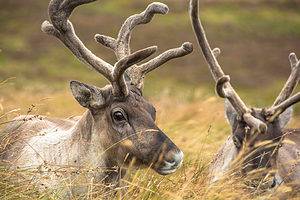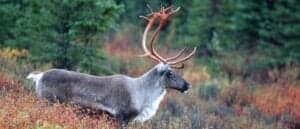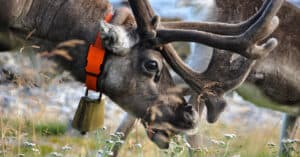Quick Answer:
- Female reindeer utilize their antlers to be socially dominant and in the best physical shape, as well as to protect their food or territory.
- Generally, reindeer grow antlers to compete for mates and protect their territory during rutting season.
- Female reindeer grow antlers that are significantly smaller than their male counterparts–20 inches in length, while males’ antlers grow as long as 50 inches after multiple seasons of shedding.
It’s a common truth in the world of deer that males have antlers and females don’t, but reindeer serve as the exception that proves the rule. Both male and female reindeer grow antlers, and they actually keep them for differing lengths of time.
That’s a trait that no other species in the deer family possesses. The reason is a peculiar result of circumstances and biological luck, but it’s a reflection of how sophisticated the natural world can be.
Understanding Antlers
Antlers and horns are sometimes used interchangeably, but there are some distinctions between the two that are worth noting. Antlers are constructed of bone that’s chemically identical to any other bone in the animal’s body, although they’re protected by a sheath of keratin — the same protein that makes up our hair and our fingernails and toenails.
The primary distinguishing point between antlers and horns is that the former is seasonal while the latter is permanent. Antlers are the fastest-growing tissue on the planet — and they can expand at a rate of up to an inch a day. The primary reason why antlers manage to grow so quickly is thanks to a material known as velvet.
This dense coating lines the exterior of the growing antler and consists of dense blood vessels that provide the antlers with nutrients and help shield against the risk of infection. The bone grows outward as an extension of the skull so that it isn’t in pain while shedding its antlers.
Antlers are made of bone and covered with “velvet”—a thin, soft layer of skin and blood vessels that gets scraped off the antler over time. Later in the year, those antlers are shed, making room for a new set to grow in.
Why Deer Grow Antlers
Before we can discuss why female reindeer have the unique trait of growing antlers, we have to understand what these unique physiological characteristics are and what purpose they traditionally serve in the wild.
The primary reason why deer grow antlers — and the one that makes the presence of antlers in female reindeer stranger — is to compete for mates and protect their territory during rutting season. In fact, the growth and loss of antlers for most species of deer coincide closely with rutting season.
In the case of reindeer, males will begin growing their antlers in February and shedding them in November or December. This leaves them without antlers for two or three months and ensures that their antlers are at their largest and strongest during rutting season — approximately from late September into late October or November.
Antlers won’t necessarily grow back in the same form every year, and larger horns will usually denote older males. Each seasonal return of the antler is more magnificent than the last.
Additionally, female bovids have horns that are used to defend either food or territory from other females. In the same way, reindeer use antlers tend to be socially dominant and in the best physical shape.
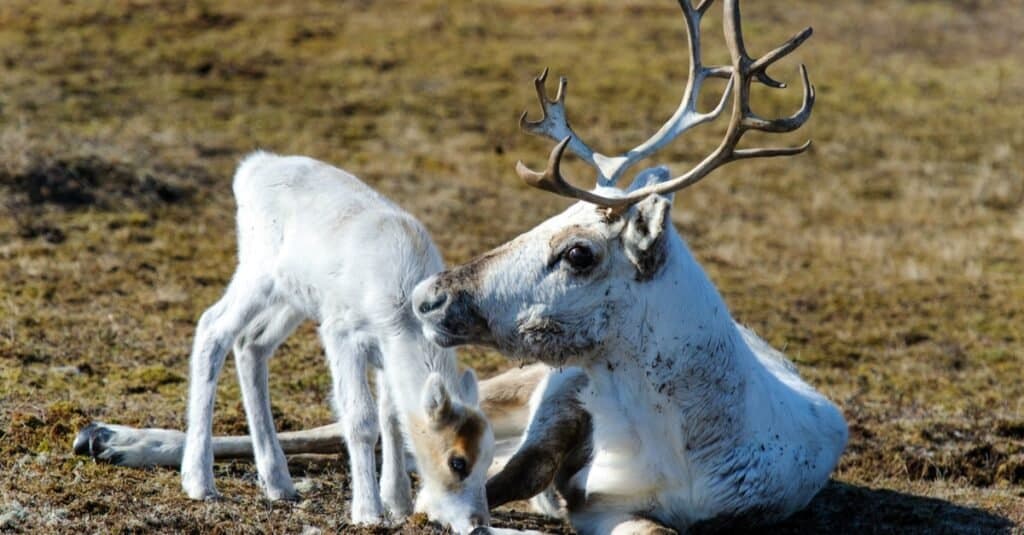
©V. Belov/Shutterstock.com
How Reindeer Use Their Antlers
Antlers seem to have developed exclusively as a social mechanism, and one particularly related to the breeding cycle of deer. Reindeer travel in herds, but the males are also highly competitive for mates. During mating season, male reindeer will test one another’s resolve in establishing territorial lines and clash over which partners they’ll be allowed to breed with.
Sometimes a larger pair of horns is enough to keep a potential suitor away, but it’s not uncommon for reindeer to come to blows.
Older male reindeer have large antlers, and that typically allows the control of more territory and interest from more females. As a result, older males tend to be more polygamous. Once rutting season is over, younger males will typically abandon the herd to join a bachelor herd until the mating season begins once more.
Older males may stay with their existing herd or may migrate elsewhere, but females will generally stay with their sisters and mothers in the same herd for their entire lives.
How Female Bovine Species Use Their Horns
A bovine animal is a reference to a wide variety of roaming animals with horns — and it includes a variety of species that include goats, oxen, cattle, and sheep. And while a horn distinguishes itself by being a permanent structure rather than something that goes through a shedding process each year, it’s also a defensive tool that’s employed by males to maintain breeding status.
These herd creatures employ very similar habits to deer — and since female bovids grow horns, there’s a reasonable connection that traces to reindeer.
That’s because while many male bovids developed horns primarily as a way to compete for mates, female bovids developed antlers as a defense mechanism against predators and to defend their food. Horns tend to be more prominent in females of larger species or those that live in high-visibility environments like grasslands.
In other words, defensive horns tend to develop in species that are less capable of hiding from predators. Moreover, this tends to be the case in species where males travel in bachelor herds — because it often results in herds of predominantly female animals having to shelter their children from predators. Caribou occupy a similar situation.
The Antler Cycle of Female Reindeer
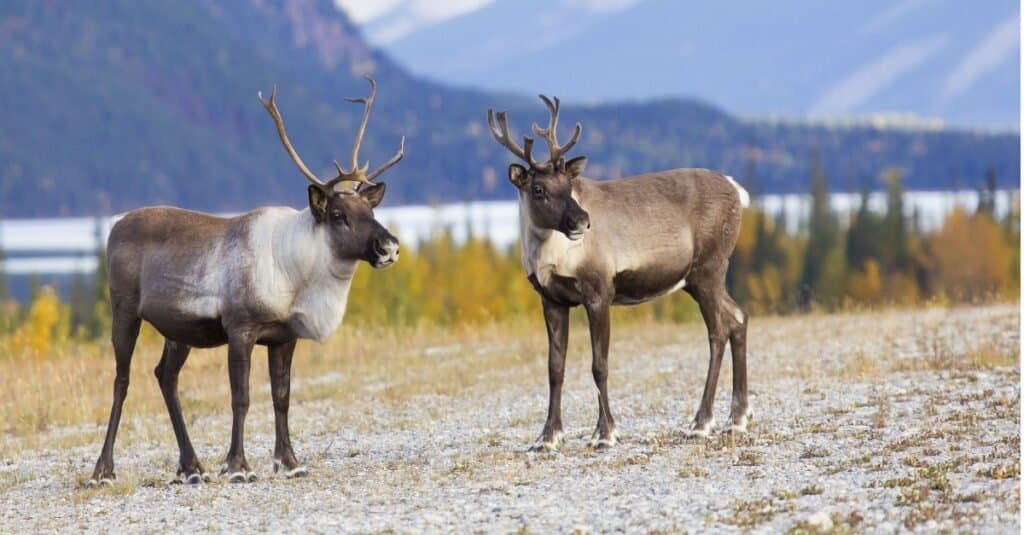
©iStock.com/RichardSeeley
Female reindeer grow antlers that are significantly smaller than their male counterparts. A male can grow antlers as long as 50 inches after multiple seasons of shedding, while a female is more inclined to grow 20-inch antlers. But the two can also be distinguished by the lengths of time that they keep their antlers.
Females shed their antlers in May, just after their calves are born — but they begin to grow their antlers back later in the same month. That leaves a very narrow period of time in which female reindeer don’t have antlers, and it ensures that their antlers are at the fullest during the vulnerable months of pregnancy.
Reindeer herds are highly protective of their members — and especially their young — but that doesn’t mean that there isn’t competition among females for resources. Since males rarely stick around to help with the raising of fawns, mother reindeer need to rely on their own wits to survive in the wild and ensure that their pregnancy is healthy.
For deer that live in ecosystems with abundant food, competition between females isn’t necessary. That’s not the case for reindeer.
One strong hypothesis for why female caribou evolved to grow antlers is the habitat they live in — cold tundra with a notable lack of resources. A higher level of competition for food led to the development of more aggressive features in females. That seems to reflect itself in the social structure of reindeer herds. It’s one where females with larger antlers enjoy higher social standing and better access to food.
That’s partly thanks to the functional role that antlers serve for reindeer. The impressive size of a reindeer antler’s horns certainly makes them good weapons for defense, but these antlers can also serve as an important scavenging tool out in the wild. Antlers are used to dig potential food sources out of the frozen tundra and define territory.
When the rutting is over and the deepest ravages of winter set in, caribou mothers are often left to tend to themselves without male care.
And for the roughest months of the year, they use these impressive bone tools to carve out their own sustenance.
Up Next…
- Reindeer Antlers: Everything You Need to Know: Wanna know about antlers? Check out these interesting facts that you probably didn’t know!
- Are Reindeer Real? Find Out Here!: You might be wondering what is real and fantasy when it comes to these animals. Read on to learn about reindeer
- Caribou vs Reindeer: 4 Main Differences Explained: Let’s look at the significant differences between these majestic creatures
The photo featured at the top of this post is © Vladimir Melnikov/Shutterstock.com
FAQs (Frequently Asked Questions)
Why are all Santa's reindeer female?
Santa’s reindeer are known for their incredible ability to fly and their magnificent antlers, but science suggests that they have to be female. Male reindeer shed their antlers annually in November, meaning they’re bald when it comes time for Saint Nick to set out on his journey. But female reindeer keep their antlers through May.
Thank you for reading! Have some feedback for us? Contact the AZ Animals editorial team.



